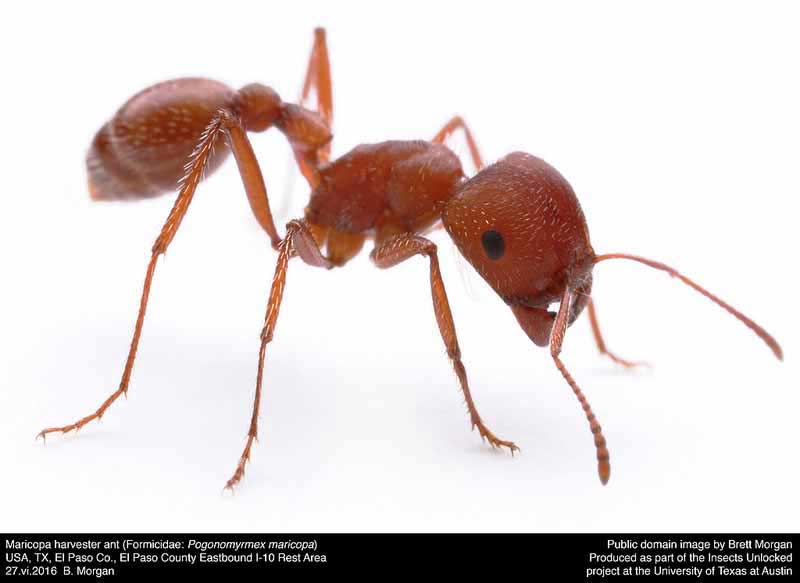
Superregnum: Eukaryota
Cladus: Unikonta
Cladus: Opisthokonta
Cladus: Holozoa
Regnum: Animalia
Subregnum: Eumetazoa
Cladus: Bilateria
Cladus: Nephrozoa
Cladus: Protostomia
Cladus: Ecdysozoa
Cladus: Panarthropoda
Phylum: Arthropoda
Subphylum: Hexapoda
Classis: Insecta
Cladus: Dicondylia
Subclassis: Pterygota
Cladus: Metapterygota
Infraclassis: Neoptera
Cladus: Eumetabola
Cladus: Endopterygota
Superordo: Hymenopterida
Ordo: Hymenoptera
Subordo: Apocrita
Superfamilia: Formicoidea
Familia: Formicidae
Subfamilia: Myrmicinae
Tribus: Pogonomyrmecini
Genus: Pogonomyrmex
Species: Pogonomyrmex maricopa
Name
Pogonomyrmex maricopa Wheeler, 1914: 155
Synonyms
Pogonomyrmex californicus barnesi Smith
Pogonomyrmex californicus sinaloanus Olsen
Pogonomyrmex maricopa barnesi Smith
References
Wheeler, W.M. 1914: New and little known harvesting ants of the genus Pogonomyrmex. Psyche, 21: 149–157.
Bert Hölldobler 1976: Recruitment behavior, home range orientation and territoriality in harvester ants, Pogonomyrmex. Behavioral Ecology and Sociobiology, 1 (1): 3–44.
William P. MacKay 1981: A Comparison of the Nest Phenologies of Three Species of Pogonomyrmex Harvester Ants (Hymenoptera: Formicidae). Psyche, 88 :25-74.
Vernacular names
English: Maricopa Harvester Ant
Pogonomyrmex maricopa, the Maricopa harvester ant, is one of the most common species of harvester ant found in the U.S. state of Arizona,[1] but it is also known from California, Colorado, New Mexico, Nevada, Texas and Utah, and the Mexican states of Baja California, Chihuahua, Sinaloa and Sonora.[2] Its venom is believed to be the most toxic insect venom in the world.[3]
Their nest mounds are likely to incorporate rocks and gravel. The ants construct cemented caps on the sand mound nests in a fine sand dune area. The caps are approximately 60% calcium carbonate that is transported from the underlying calcium carbonate layers, and protect the nest structure from being eroded away during high-wind periods. Partial erosion of the cemented caps adds calcium carbonate to the sand dune soils.[4]
Venom and attack method
The toxicity of the venom of the Maricopa harvester ant is well known. Its LD50 value is 0.12 mg/kg (injected intravenously in mice); 12 stings can kill a 2-kg rat. In comparison, the LD50 of the honey bee is 2.8 mg/kg—less than 1/20th as strong. In humans, a Pogonomyrmex sting produces intense pain that can last up to four hours.[3][5]
Like that of many venomous insects, the venom of the Maricopa harvester ant consists of amino acids, peptides, and proteins. This may also encompass alkaloids, terpenes, polysaccharides, biogenic amines, and organic acids. The most notable component found in the venom of the Maricopa harvester ant is an alkaloid poison—this releases an "alarm" pheromone that chemically alerts other ants in the vicinity. This is an example of chemical signaling, which explains why ants all appear to sting at once.
Similar to the two-part process of the fire ant bite and sting, the harvester ant will attach to the victim with its mandibles, and so proceed by pivoting around the site, allowing the ant to repeatedly sting and inject venom into the region.
The Maricopa harvester ant plays a major role in decomposition by dragging dead carcasses of insects underground, thereby enriching soil for plants and crops.
References
Harvester Ants (Pogonomyrmex spp.) Archived 2004-09-10 at the Wayback Machine — Urban Integrated Pest Management
D. L. Quinn. "Pogonomyrmex maricopa". Retrieved 19 August 2016.
W. L. Meyer (1996-05-01). "Chapter 23 — Most Toxic Insect Venom". Book of Insect Records. University of Florida. Archived from the original on 2012-06-01.
Whitford, Walter G. (2003). "The functional significance of cemented nest caps of the harvester ant, Pogonomyrmex maricopa". Journal of Arid Environments. 53 (2): 281–4. doi:10.1006/jare.2002.1039.
Anne Marie Helmenstine. "World's Most Venomous Insect". About.com.
Retrieved from "http://en.wikipedia.org/"
All text is available under the terms of the GNU Free Documentation License

